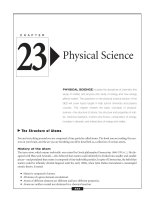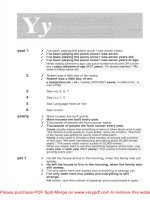2 11 all about sound (physical science)
Bạn đang xem bản rút gọn của tài liệu. Xem và tải ngay bản đầy đủ của tài liệu tại đây (3.96 MB, 14 trang )
Genre
Nonfiction
Comprehension Skill
Important Details
Text Features
• Glossary
• Labels
• Captions
Science Content
Sound
Scott Foresman Science 2.11
ISBN 0-328-13800-2
ì<(sk$m)=bdia f< +^-Ä-U-Ä-U
Vocabulary
What did you learn?
loudness
pitch
vibrate
1. How can an object make sound?
Picture Credits
Every effort has been made to secure permission and provide appropriate credit for photographic material.
The publisher deeply regrets any omission and pledges to correct errors called to its attention in subsequent editions.
Photo locators denoted as follows: Top (T), Center (C), Bottom (B), Left (L), Right (R), Background (Bkgd).
2 Aflo Photo/Alamy Images; 9 (CL) ©Jerry Young/DK Images; 14 Chad Slattery/Getty Images; 16 Doug Perrine/Nature
Picture Library; 22 (TR) Fred Bavendam/Minden Pictures; 23 Alan Curtis/Alamy Images.
Scott Foresman/Dorling Kindersley would also like to thank: 7 (TL), 9 (TR) Stephen Oliver/DK Images;
20 (C) Natural History Museum, London/DK Images.
ISBN: 0-328-13800-2
Copyright © Pearson Education, Inc. All Rights Reserved. Printed in the United States of America.
This publication is protected by Copyright, and permission should be obtained from the publisher prior to any
prohibited reproduction, storage in a retrieval system, or transmission in any form by any means, electronic,
mechanical, photocopying, recording, or likewise. For information regarding permission(s), write to
Permissions Department, Scott Foresman, 1900 East Lake Avenue, Glenview, Illinois 60025.
3 4 5 6 7 8 9 10 V010 13 12 11 10 09 08 07 06 05
2. What is the difference between
loudness and pitch?
3.
Snapping shrimp
make sounds
like popping
a balloon.
by Kirsten
Anderson
Write to explain how this works.
4.
Important Details You can make
sound travel through string. Page 19
tells you how to do this. What are
the important details you need to
know to make this work?
What is sound?
Stop and listen. What do you hear?
Maybe you hear voices. Maybe you
hear cars. Maybe you hear birds singing.
You might even hear music playing.
2
Those are all different sounds. Sound is
made when an object vibrates. Vibrate
means to move quickly back and forth.
3
When you sing, parts of your throat vibrate.
Put your fingers on the front of your throat
and talk. Do you feel the buzz under your fingers?
Those are your vocal cords vibrating.
4
A guitar has strings. When the strings vibrate,
they make sound. You can see the guitar strings
in this picture.
5
Loudness
megaphone
whistle
baby
alarm clock
Sounds are not all the same. They are
different in some ways. Loudness is one way
to explain different sounds. Sound can be
loud or soft.
6
Sound can be loud. Look at the pictures.
These things make loud sounds. You can
make a loud sound when you shout.
7
Pitch
paper airplane
triangle
gong
butterfly
whispering
Sound can be soft. The things in these
pictures make soft sounds. You can make
a soft sound when you whisper.
8
Pitch is another way to explain sound.
Pitch can be high or low. Objects that vibrate
quickly make a high-pitched sound. Objects
that vibrate slowly make a low-pitched sound.
9
You can use bottles filled with water to
make high-pitched or low-pitched sounds.
Fill some bottles with a lot of water.
Fill some bottles with a little water.
Blow over the tops of the bottles.
This makes the air inside the bottles
vibrate. The bottles with a lot of air
will make a low-pitched sound.
The bottles with a little air will
make a high-pitched sound.
Blow over the tops of bottles
of water. The bottles will
make different sounds.
10
11
Animals make sounds with different pitches.
A lion’s roar has a low pitch. A cat’s meow
has a high pitch.
Look at the pictures. Which ones show
high-pitched sounds? Which ones show
low-pitched sounds?
cow
playing the
double bass
cat
lion
playing
the recorder
mouse
12
13
Sound Travels
Sound can move through gases, liquids,
and solids.
Sound travels through gases. Air is
a gas.
14
Look at the picture of the roller coaster.
The riders are shouting.
The other people in the park can hear them.
They can hear them because sound travels
through air.
15
Water is a liquid. Sound can travel through
liquids. Sound travels faster through liquids than
through gases. Sound travels faster through
water than through air.
16
Whales make sounds. Their sounds travel
through water. Other whales can hear these
sounds many miles away.
17
Sound travels through solids. Sound
travels faster through solids than through
either gases or liquids.
A string is a solid. Sound can travel
through string.
18
Take two cups. Tie them together with
a long piece of string. Stand in one room
with one cup. Send a friend to another room
with the other cup. Pull the string tight. Speak into
the cup. Your friend will quickly hear your voice.
19
Animal Sounds
bugle
drum
cicada
elephant
Animals make sounds using parts of
their bodies. Cicadas vibrate small parts
of their bellies. This works like tiny drums.
Elephants blow air through their trunks.
Their trunks vibrate. This works like playing
a bugle.
20
21
Sound Is All
Around You
snapping shrimp
popping a balloon
Snapping shrimp make sounds with their
large claws. The shrimp open and close their
claws fast. They catch air bubbles in their claws.
Then the bubbles pop. This works like popping
a balloon.
22
Now you know how sound is made. Sound
can be loud or soft. Sound can be high pitched
or low pitched. Sound can travel fast or slow.
Next time you are outside, listen to the sounds
around you. The world is full of sound!
23
Vocabulary
Glossary
loudness
pitch
vibrate
loudness
how loud or quiet a sound is
pitch
how low or high a sound is
vibrate
to move quickly back and forth
Picture Credits
Every effort has been made to secure permission and provide appropriate credit for photographic material.
The publisher deeply regrets any omission and pledges to correct errors called to its attention in subsequent editions.
Photo locators denoted as follows: Top (T), Center (C), Bottom (B), Left (L), Right (R), Background (Bkgd).
2 Aflo Photo/Alamy Images; 9 (CL) ©Jerry Young/DK Images; 14 Chad Slattery/Getty Images; 16 Doug Perrine/Nature
Picture Library; 22 (TR) Fred Bavendam/Minden Pictures; 23 Alan Curtis/Alamy Images.
Scott Foresman/Dorling Kindersley would also like to thank: 7 (TL), 9 (TR) Stephen Oliver/DK Images;
20 (C) Natural History Museum, London/DK Images.
ISBN: 0-328-13800-2
Copyright © Pearson Education, Inc. All Rights Reserved. Printed in the United States of America.
This publication is protected by Copyright, and permission should be obtained from the publisher prior to any
prohibited reproduction, storage in a retrieval system, or transmission in any form by any means, electronic,
mechanical, photocopying, recording, or likewise. For information regarding permission(s), write to
Permissions Department, Scott Foresman, 1900 East Lake Avenue, Glenview, Illinois 60025.
24
3 4 5 6 7 8 9 10 V010 13 12 11 10 09 08 07 06 05
What did you learn?
1. How can an object make sound?
2. What is the difference between
loudness and pitch?
3.
Snapping shrimp
make sounds like popping a balloon.
Write to explain how this works.
4.
Important Details You can make
sound travel through string. Page 19
tells you how to do this. What are
the important details you need to
know to make this work?









